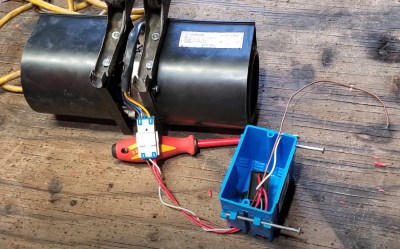You don’t have to look hard to find a broken microwave. These ubiquitous kitchen appliances are so cheap that getting them repaired doesn’t make economical sense for most consumers, making them a common sight on trash day. But is it worth picking one of them up?
The [DuctTape Mechanic] certainly thinks so. In his latest video, he shows how the exhaust fan from a dead microwave can easily and cheaply be adapted to blow smoke and fumes out of your workshop. While it’s obviously not going to move as much air as some of the massive shop fans we’ve covered over the years, if you’re working in a small space like he is, it’s certainly enough to keep the nasty stuff moving in the right direction. Plus as an added bonus, it’s relatively quiet.
 Now as you might expect the exact internal components of microwave ovens vary wildly, so there’s no guarantee your curbside score is going to have the same fan as this one. But the [DuctTape Mechanic] tries to give a relatively high-level overview of how to liberate the fan, interpret the circuit diagram on the label, and wire it up so you can plug it into the wall and control it with a simple switch. Similarly, how you actually mount the fan in your shop is probably going to be different, though we did particularly like how he attached his to the window using a pair of alligator clips cut from a frayed jumper cable.
Now as you might expect the exact internal components of microwave ovens vary wildly, so there’s no guarantee your curbside score is going to have the same fan as this one. But the [DuctTape Mechanic] tries to give a relatively high-level overview of how to liberate the fan, interpret the circuit diagram on the label, and wire it up so you can plug it into the wall and control it with a simple switch. Similarly, how you actually mount the fan in your shop is probably going to be different, though we did particularly like how he attached his to the window using a pair of alligator clips cut from a frayed jumper cable.
Got a donor microwave but not in the market for a impromptu shop fan? No worries. We recently saw a dud microwave reborn as a professional looking UV curing chamber that would be the perfect partner for your resin 3D printer. Or perhaps you’d rather turn it into a desktop furnace capable of melting aluminum, copper, or bronze.

















I have been constructing a home chemistry lab and found that an 80mm EDF intended for a RC jet makes an excellent exhaust fan. (Derating the motor’s maximum power by a factor of four by driving it from a 12v supply rather than the nominal 24v ot supports) I can run itvat 100% duty cycle for days at a time.
Drawing ~250W and moving ~350cfm measured at the far side (outdoor vent) it does a good job of expelling noxious or unpleasant vapors from under the fume hood *and* being brushless means that it doesn’t spark and risk igniting any flammable duat or vapors my experiments may generate.
It remains to be seen how corrosion resistant the motor windings’ enamel is but the anodized case itself and windings both have held up OK venting sulfur trioxide vapor, as well as the fumes that arise from white fuming nitric acid but since the motor+EDF+housing unit is meant for a high speed easy-to-crash RC plane it is available as an inexpensive replacement part so we’ll see.
I just figured I’d point out that any brushed AC or DC motor is a potential explosion hazard with fine sawdust or flammable vapors.
250W for only 350cfm is really not efficient. There must be a mistake. My shop exhaust fan takes 630cfm out for 350W.
You should have some way to show if the fan stops working when using the hood, or even better have two fans running, one as a backup because if your doing something releasing nasty gas and the fan goes out could be bad.
“These ubiquitous kitchen appliances are so cheap that getting them repaired doesn’t make economical sense for most consumers, making them a common sight on trash day.”
Or even physical. My old one burned through the inside sidewall.
Did it burn through the metal, or through the waveguide diffuser plate?
The latter burning up because of too much accumulated grease is actually quite common, and replacements are available for about 5-10 EUR online.
You are not in the home improvement department at the moment. Please add “for dummies” in your google search.
I took a little time today to stare for a few at the bin of microwave parts, since these are in the “want to save and not planning to use yet” section.
Was also reminded of the toaster oven parts bin, since one or two microwaves came with quarts heating elements, where I’m not quite ready yet to use… though do have future plans for.
The flower bulb crates are handy since larger than the milk crates and not as deep/tall.